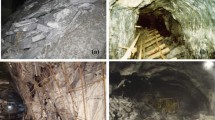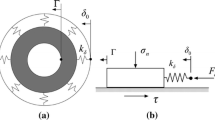Abstract
Geological masses can be regarded as rock blocks of different scale of structural planes with the ability to store various forms of energy. Propagation of stress waves generated by weak external disturbances in rock blocks may trigger the release of internal potential energies and slip movements along these structural planes, resulting in seismic events, such as residual deformations, fault-slip rock bursts, ground motions, etc. First, based on a simplified rock block system, a novel experimental system, and a numerical model, we investigated weak disturbance-triggered seismic events. We then conducted a theoretical analysis in which we quantitatively characterized the critical energy conditions of seismic events. The experimental and numerical results showed that the tensile stages of the stress waves generated by the disturbance loading reduced the normal stress on the interface of adjacent blocks, leading to an ultra-low friction phenomenon. This phenomenon resulted in the slip movements of the work block. The residual displacements and the critical energy conditions significantly depended on the initial stress states. As the initial shearing force ratio β increased, greater residual displacements were observed and lower disturbance energy was required to trigger a seismic event. When β was close to 1, even an extremely weak disturbance was able to trigger large residual displacements or sustainable slip failures. A dimensionless parameter k was introduced to characterize the critical energy conditions of the seismic events. The critical condition for initiating a slip was that k should exceed a critical value, while the critical conditions for a slip failure were that k should reach a larger critical value and the work block should be in a subcritical stress state. It can be concluded that disturbances, initial shear forces, and friction-weakening mechanisms are the most important factors, with the initial shear forces providing the potential energies, which are locked by the static friction force (the shear strength). The disturbances reduce the shear strength and weaken the restrictions. The friction-weakening mechanisms determine energy conversion coefficient efficiency.

















Similar content being viewed by others
References
Bao X, Eaton DW (2016) Fault activation by hydraulic fracturing in western Canada. Science 354(6318):1406–1409. https://doi.org/10.1126/science.aag2583
Glasstone S, Dolan PJ (1977) Effects of nuclear weapons. Department of Defense and Department of Energy, Washington, DC
Gomberg J, Reasenberg PA, Bodin P, Harris RA (2001) Earthquake triggering by seismic waves following the Landers and Hector Mine earthquakes. Nature 411:462–466
Gomberg J, Bodin P, Larson K, Dragert H (2004) Earthquake nucleation by transient deformations caused by the M= 7.9 Denali, Alaska, earthquake. Nature 427:621–624
Hill DP, Reasenberg PA, Michael A, Arabaz WJ, Beroza G, Brumbaugh D, Brune JN, Castro R, Davis S, DePolo D, Ellsworth WL, Gomberg J, Harmsen S, House L, Jackson SM, Johnston MJS, Jones L, Keller R, Malone S, Munguia L, Nava S, Pechmann JC, Sanford A, Simpson RW, Smith RB, Stark M, Stickney M, Vidal A, Walter S, Wong V, Zollweg J (1993) Seismicity remotely triggered by the magnitude 7.3 Landers, California, earthquake. Science 260:1617–1624
Kocharyan GG, Spivak AA (2001) Movement of rock blocks during large-scale underground explosions. Part I: experimental data. J Min Sci 37:64–76
Kocharyan GG, Kulyukin AA, Markov VK, Markov DV, Pavlov DV (2005) Small disturbances and stress-strain state of the Earth’s crust. Phys Mesomech 8:21
Kocharyan GG, Kulyukin AA, Markov VK, Markov DV, Pernik LM (2008) Critical deformation rate of fracture zones. Dokl Earth Sci 418:132–135. https://doi.org/10.1134/S1028334X08010297
Kurlenya MV, Oparin VN, Eremenko AA (1993) Relation of linear block dimensions of rock to crack opening in the structural hierarchy of masses. J Min Sci 29:197–203. https://doi.org/10.1007/BF00734666
Kurlenya MV, Oparin VN, Vostrikov VI (1996a) Pendulum-type waves. Part II: Experimental methods and main results of physical modeling. J Min Sci 32:245–273
Kurlenya MV, Oparin VN, Vostrikov VI, Arshavskii VV, Mamadaliev N (1996b) Pendulum waves. Part III: Data of on-site observations. J Min Sci 32:341–361
Kurlenya MV, Oparin VN, Vostrikov VI (1997) Anomalously low friction in block media. J Min Sci 33:1–11
Kurlenya MV, Oparin VN, Vostrikov VI (1999) Effect of anomalously low friction in block media. J Appl Mech Tech Phys 40:1116–1120
Ma GW, An XM, Wang MY (2009) Analytical study of dynamic friction mechanism in blocky rock systems. Int J Rock Mech Min Sci 46:946–951
Olsson H, Åström KJ, Canudas de Wit C, Gäfvert M, Lischinsky P (1998) Friction models and friction compensation. Eur J Control 4(3):176–195
Qi CZ, Qian QH, Wang M-Y, Dong J (2005) Structural hierarchy of rock massif and mechanism of its formation. Chin J Rock Mech Eng 24:2838–2846
Rabinowicz E (1951) The Nature of the Static and Kinetic Coefficients of Friction. J Appl Phys 22:1373–1379. https://doi.org/10.1063/1.1699869
Sadovskiy MA (1979). Natural lumpiness of rocks. DAN USSR 247(4):829–831
Tan T (1988) Rockbursts, case records, theory and control. In: Proc Int Symp on Engineering in Complex Rock Formations. Pergamon Press, Oxford pp. 32–47. https://doi.org/10.1016/B978-0-08-035894-9.50008-1
Varoto PS, de Oliveira LP (2002) Interaction between a vibration exciter and the structure under test. Sound Vib 36:20–26
Wang M, Li J, Ma L, Huang H (2016) Study on the characteristic energy factor of the deep rock mass under weak disturbance. Rock Mech Rock Eng 49:3165–3173. https://doi.org/10.1007/s00603-016-0968-2
Wang MY, Qi CZ, Qian QH (2005) Study on deformation and motion characteristics of blocks in deep rock mass. Chin J Rock Mech Eng 16:2825–2830
Acknowledgements
The present study was funded by the National Natural Science Foundation of China (Grant No.51527810; 51679249).
Author information
Authors and Affiliations
Corresponding author
Rights and permissions
About this article
Cite this article
Li, J., Deng, S., Wang, M. et al. Weak disturbance-triggered seismic events: an experimental and numerical investigation. Bull Eng Geol Environ 78, 2943–2955 (2019). https://doi.org/10.1007/s10064-018-1292-8
Received:
Accepted:
Published:
Issue Date:
DOI: https://doi.org/10.1007/s10064-018-1292-8




